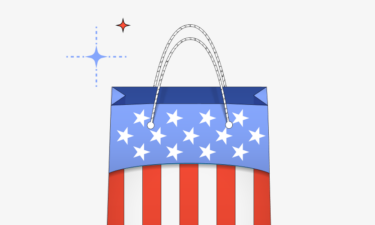As more and more eCommerce retailers from Amazon to Alibaba are making pledges related to sustainability in order to reduce their heavy carbon footprints and to appeal to the desires of the more eco-conscious consumer, it’s evident that sustainability should be a priority for eCommerce companies. Keep reading to learn seven strategies to improve your brand’s sustainability practices.
What is Sustainability?
The goal of sustainability from the US National Environmental Policy Act (NEPA) of 1969 is to “create and maintain conditions, under which humans and nature can exist in productive harmony, that permit fulfilling the social, economic, and other requirements of present and future generations.”
So, let’s break down this definition. There are three pillars or categories that work together to qualify something as sustainable.
- Environmental: Some examples of initiatives in this category include maintaining air quality standards, reducing contaminants in water systems, protecting the health of natural habitats or ecosystems, and using green engineering to eliminate toxins.
- Social: This pillar encompasses human health, student education, ensuring human access to basic resources, and environmental justice for communities impacted by pollution.
- Economic: This category includes financial factors such as jobs, supply and demand, incentives, costs, and prices.
Informally, the three pillars are referred to as the planet, the people, and the profits. Sustainability is not a simple, one and done checklist. In conjunction, these three principles must collaborate in a holistic manner in order to secure long term change over time rather than fulfill a temporary checklist.
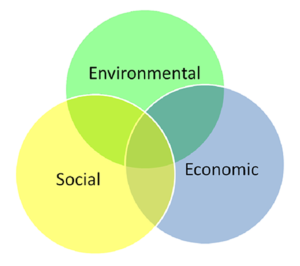
Source: Environmental Protection Agency (EPA)
Why Sustainability Matters
When it comes down to shopper opinions, the link between eCommerce and sustainability is clear. Public opinion shows that individuals care about the environment, and they want to feel good about their purchases.
A June 2020 Statista survey of US, UK, and Canadian Amazon shoppers revealed that 87% of respondents wanted major retailers to increase their rate of plastic recycling[*]. In a Nielson global study in 2018, 81% of global respondents feel strongly that companies should help improve the environment[*].
The widespread international and cross-generational passion for corporate environmental responsibility is not to be ignored.
In the News: eCommerce Sustainability Pledges
The Swedish furniture retailer, Ikea, pledges by 2030 to have all their plastic products based on renewable or recyclable material[*]. For their home decor and furniture products, they’re transparent in their goals to source their raw materials such as wool for rugs and wood for furniture that abides by the Responsible Wool Standard (RWS) guidelines and is certified by the Forest Stewardship Council (FSC).
Amazon retailer pledged in 2019 to co-found The Climate Pledge with Global Optimism, committing to net zero carbon emissions by 2040, ten years ahead of the Paris Agreement schedule[*]. Details of this pledge involve offsetting emissions by improving efficiency, relying more heavily on renewable energy, materials reduction, and carbon emission elimination strategies.
Etsy marketplace, the first global eCommerce company to offset carbon emissions from shipping in 2019, announced their plans to continue offset their carbon footprint in February 2021, pledging for net zero emissions by 2030 for scope type one, two, and three gas emissions[*].
Greenhouse Gas Emissions Scopes

For Singles’ Day in 2021, Alibaba announced that they will highlight eco-friendly products on their online platform, including $15.7 million worth of “green” vouchers in an effort to encourage consumption of environmentally friendly products. Additionally, through the retailer’s logistics partnership with Cainiao Network, they will implement a package recycling program to diminish the holiday’s carbon footprint.
3 Examples of Green eCommerce Campaigns
Not only are eCommerce brands publicly announcing corporate sustainability pledges, but they’re also infusing green marketing strategies into their campaigns themselves, whether or not they sell green products. To bring more awareness to the environmental causes, eCommerce brands are partnering with global conservation groups, international news resources, and even environmentally minded data companies.
If you’re looking for inspiration, here are three examples of brands that creatively infuse their marketing campaigns with the three pillars of sustainability: environmental, social, and economic.
1.Lacoste X IUCN
As part of a three year environmentalist project, global apparel brand, Lacoste, partnered with the International Union for Conservation of Nature (IUCN) in 2018 as part of their “Save our Species” campaign. For this awareness initiative, they released limited-edition polo shirts, featuring the embroidery of ten different endangered species instead of their famous crocodile brand logo. To further emphasize the dire reality of endangered animals on the brink of extinction, Lacoste only released a limited number of shirts for each species, corresponding with the number of known individual animals remaining in the wild. For example, they only produced 90 shirts featuring the Addax embroidery and 589 shirts for the Iberian Lynx. Profits from the sale of these 3,520 shirts were used to fund conservation efforts for these very animals. Lacoste’s use of FOMO and scarcity tactics in tandem with wildlife conservation efforts is a brilliant example of how creative marketing strategy and sustainability can go hand in hand in the product offering itself and the distribution methods.
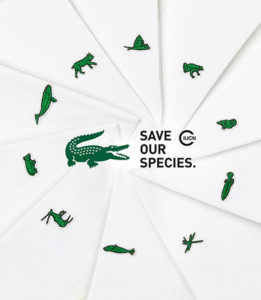
Source: Flame Magazine
2.Everlane X NYT
San Francisco based retailer, Everlane, is no novice when it comes to sustainable branding, products, and environmental initiatives[*]. As part of their “ReNew” collection, the eCommerce business sells men and womens’ clothing products such as puffer jackets made from recycled plastics. As of April of 2021, the 97% of the brand’s apparel fabrics containing polyester and nylon are made from certified recycled fibers, including plastic water bottles, fishing nets, and fabric excess from cutting patterns. 45% of their plastic footwear components are now made from recycled materials, and 100% of their virgin plastic shipping bags are now made from either 100% recycled plastic or FSC-certified paper for packaging.
In 2019, Everlane partnered with the New York Times in an effort to educate the public about climate change through linking to relevant articles on their website. Everlane states that, “the planet belongs to the next generation of readers.” As part of this collaboration, for every product sold in the Climate Collection, nine public school students received digital access to the NYT through its subscriptions sponsorship program. While this partnership may seem unusual, it’s an interesting case study of how eCommerce brands can creatively combine their product offerings with educational sustainability goals.

Source: Everlane
3.Klarna X Doconomy
Other eCommerce adjacent companies are launching campaigns with a focus on sustainability, specifically in regards to economic elements. In honor of Spring 2021’s Earth Day, European Buy Now Pay Later service, Klarna, launched a new, free feature on their app for their 90 million consumers to track their carbon footprint[*]. Every purchase that shoppers make through Klarna’s payment option will come with a report of their carbon dioxide emissions. To implement this new feature, they’re in partnership with Doconomy, a leading data service company for corporations that aims to “educate, engage, and reduce environmental impact[*].”
At first glance, this initiative seems unusual. Why would a company that profits from eCommerce consumption want to inform their shoppers of the negative environmental consequences of consumerism? Wouldn’t this decrease their own profits? However, CEO Sebastian Siemiatkowski that creating mindful, informed shoppers is important:
“With fat, sugar and salt levels labeled on food we buy, why shouldn’t our CO2 emissions be just as visible? This type of information shouldn’t be a premium or luxury that consumers pay for, but rather an essential part of every shopping journey. That’s why we’re upgrading our app to give all our consumers globally transparent access to their shopping carbon footprint. We all make decisions that affect the health of the planet and it’s essential that everyone has access to sound information to make smart climate choices in a simple and straightforward way.”

Source: Klarna
Related Material: Investigating the Buy Now Pay Later Payment Solution
7 Strategies to Improve Sustainability
Now that you’ve seen several examples of sustainability focused partnerships, consider the question: to what extent is your eCommerce business sustainably minded? There is always room for improvement. Here are seven strategies for ways to improve sustainable practices.
1. Shipping
Shipping contributes to a large carbon footprint in emissions of transporting goods from one location to another. Consider implementing a carbon neutral shipping plan, in which your carbon dioxide emissions reach a net zero through collaborative partnerships (see tip #6).
2. Packaging
Paying attention to packaging detail is everything. Consider how much waste your packaging is generating. Is your existing packaging recyclable? Compostable? Made from recycled materials? Think about using corrugated bubble wrap made of recycled cardboard instead of plastic bubble wrap, biodegradable packing peanuts made from wheat and corn rather than styrofoam, and cardboard made from recycled materials as a better alternative. Other eco-friendly packaging options include bioplastics, plant fibers, paper, and cardboard- packaging that can be reused, composted, or recycled by the user. Avoid single use plastic and make sure that items being shipped are packaged in appropriately sized boxes.
3. Manufacturing
Consider the environmental costs of production. Are you using environmentally friendly materials in the manufacturing of your goods? Have you considered using alternative energy sources such as solar and wind? How energy efficient is your production cycle, and how can you save power? How much pollution are you creating in the manufacturing of your products? Understanding your existing carbon footprint and consumption of energy and raw materials will be beneficial so that you can measure the impact of sustainable changes.
4. Consider Recommerce
A large topic in the retail industry and fast fashion is related to second hand reselling, also known as reverse commerce or recommerce, in which people sell previously owned, new, or used products. With so many products already in circulation, it’s more environmentally sustainable to encourage re-sale to minimize further production of new goods. Consider implementing programs to re-sell goods or to partner with resale platforms and services to encourage more mindful consumption.
Major retailers are incorporating this practice into their business offerings. According to Retail Dive, Ikea is planning to bring back its “Buy Back & Resell” service to 33 US stores from November 1st to December 5th in 2021[*]. The program allows for loyalty members to receive store credit for “gently used” Ikea furniture, which will be re-sold through the “as-is” section in store.
Crocs, too, is implementing similar programs for resale efforts through their partnership with ThredUp, a “resale as a service” or RaaS company. As of November 4th, 2021, Crocs customers can obtain a prepaid shipping label on ThredUp’s website and ship in their used clothing and shoes from any brand for free in exchange for Crocs shopping credit[*].
5. Prepare Your Reverse Logistics
From a Supply Chain Management point of view, the process of returning goods back to their original source is known as “reverse logistics.”

Source: Netsuite
You know how the system works. Shoppers browse online, are encouraged to checkout with incentives such as free shipping and free returns, order the product, then it arrives at their doorstep. Often, shoppers will engage in a practice called “bracketing,” in which they intentionally buy the same clothing item in multiple sizes to try on and return later, with the intention of returning an item before it even arrives. This “buy it all, return it later” mindset is not only expensive for the eCommerce business, but it’s also harmful for the environment. If you’re an online clothing retailer, you can minimize bracketing by providing comprehensive sizing guides onsite.
What happens to the products that you order online and send back? According to the Atlantic, the average rate of online returns is between 15-30%[*]. Not all of the returned goods are restocked and resold as new. In fact, many products in new condition are destroyed for sanitary reasons. It’s estimated that about 25% of returned products are discarded. This poses a massive problem in the goals of sustainability in terms of product waste, not to mention the carbon footprint of shipping and return packaging.
In order to improve your sustainability efforts, being mindful of waste minimization strategies is key. Keep these five metrics in mind.
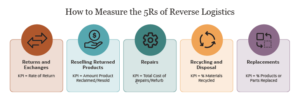
Source: Netsuite
Understanding the stress points in your reverse logistics chain can help you be more sustainable. Do you have a recycling and disposal system in place? Do you repair damaged goods? Do you sell overstocked goods to secondary markets? How might you eliminate waste by focusing on returns, exchanges, and recycling?
Related Material: Retail Supply Chain Logjams: Preparing for the 2021 Holiday Season and Beyond
6. Integrations and Partnerships with Experts
The growing demand for sustainable eCommerce is here to stay. Why not rely on industry experts organizations specializing in sustainability to guide your eCommerce business in strategy, campaigns, and collaborations?
At the NRF 2022: Retail’s Big Show, many sustainably minded organizations were highlighted, including Trove, a disruptor in the re-commerce industry, working with brands such as Lululemon and Levi’s[*]. Peer-to-peer resale market such as Recurate, is a great technology integration. Returnity is focused on reusable shipping and delivery packaging. More than 10,000 companies are working with EcoCat, a free eCommerce plugin that allows customers to support carbon footprint offsetting efforts during checkout.
7. Creative Marketing Campaigns
Thinking with a green, sustainable mindset doesn’t have to be boring. In fact, sustainability presents an opportunity to tap into your brand’s creativity. Think back to the Lacoste SOS campaign, which incorporated limited edition new product releases with environmental activism. This innovative collaboration creates both environmental good and brand buzz. Do you remember outdoor clothing retailer Patagonia’s viral advertisement in 2011 encouraging shoppers not to buy their product? Their Black Friday marketing campaign, “Don’t Buy This Jacket” campaign was risky, unprecedented, but powerful in its message. Likewise, your eCommerce brand has potential to wow shoppers through marketing campaigns with a sustainable slant.
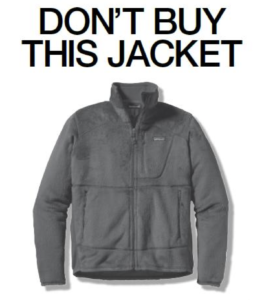
Source: Patagonia
Sustainability: A Fleeting Trend or Here to Stay?
Clearly, public opinion is in favor of more sustainable business practices. Shoppers want to feel that their purchases are good for the planet, not guilty that they’re contributing to carbon dioxide emissions and climate change. For retailers, there is a constant feedback loop of trying to satisfy customers in the offering of products themselves and to be active leaders in the social and environmental causes that shoppers care about.
With so many businesses making sustainability pledges, launching eco-friendly products, partnering with environmental organizations, promoting green marketing campaigns, and reconsidering their shipping and logistics, it’s evident that eCommerce companies are responding to shoppers’ needs and concerns.
The Importance of Authenticity
While it’s great to see eCommerce brands contributing to goals of sustainability, at the same time, these initiatives have to be authentic. Many businesses come under criticism for greenwashing, a deceptive marketing tactic in which companies falsely lead their customers to believe that they’re eco-friendly when they’re not. If your eco-friendly goals are coming from a place of genuine compassion for the environment and livelihood of those who consider it home, then shoppers will want to be a part of your brand, to buy what you’re selling.





